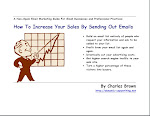An Interview With Casey Hibbard on Writing Case Studies
Posted by Charles Brown at Monday, August 04, 2008Last week I had the pleasure of interviewing Casey Hibbard about her experience and views on writing b2b case studies. Casey has written over 450 "customer success stories," as case studies are sometimes called, and also writes about how to use case studies as b2b marketing tools on her blog, Casey Hibbard's Stories That Sell.
Q: What kinds of companies have you written case studies for?
A: 90% of my customers are high tech companies,mostly software companies. I have also
written and managed case studies for non-tech companies like consultants, non-profits, insurance and employee benefit companies. I also have a client that is a
tree care company.
Q: A tree care company?
A: Yes, they were originally the customer and subject of another company's case study and liked the idea. They now use case studies to show how they handle tree care for large companies.
Q: What advice can you give a company that has never used case studies but wants to promote itself?
A: There are dozens of ways to use case studies. One company I know uses very short customer success stories that fit on post cards they send out. The Make-A-Wish Foundation plays recordings for callers that are on hold of children telling about their wishes being granted.
Of course, case studies also make good web content, and handouts for trade shows. They make excellent PR materials, but for some reason they really are
underused as PR pieces. Also, I know a graphic design company that no longer uses a brochure and instead shows customers a printed booklet full of customer success
stories.
Q: Why do you think case studies are so persuasive when other marketing tools like advertising and direct mail have difficulty producing results?
A: I wrote an article on my blog recently about what kinds of communications people trust. First were the recommendations of friends and family. But the second most trusted form of business communication was "strangers with experience." Case
studies fill a niche that nothing else can fill (credibility, education and validation). Many other forms of business communication have one or two of
these elements but not all three.
Also we all love to read about people. Stories also bring abstract concepts like technology to life. A reader can see a solution in action when they read a story.
Contrast this with a brochure, where readers may have difficulty picturing how it might help their situation.
Q: There are two schools of thought when it comes to writing case studies. One uses the traditional business school format of challenge, solution and results. The other recommends writing case studies that resemble magazine or newspaper feature rticles.
Which do you believe is most effective?
A: Definitely the feature article format. I try to move clients away from using the traditional format and toward something that more resembles a story. An added advantage to the feature story is that it makes the case study a better PR tool. Media outlets are more likely to pick them up if they are in a form that is more interesting to their readers.
Q: I understand you have a book that will be out soon, can you tell us about it?
A: It is called, "Stories That Sell: Turn Satisfied Customers into Your Most Powerful Sales & Marketing Asset," and it will be coming out this fall. I try to cover the complete process of writing customer success stories, from identifying the best customers to write about, how to approach these customers, interviewing, managing the approval process, using the stories. I spent a year interviewing companies about their best practices and have included about 20 stories of companies that have been successful using case studies. It comes out this fall.
COPYRIGHT © 2008, Charles Brown
Add to Onlywire

Labels: case studies



0 comments:
Post a Comment